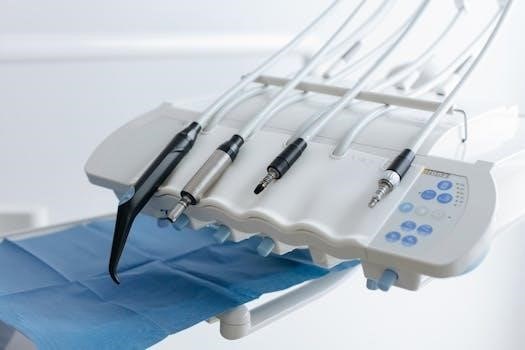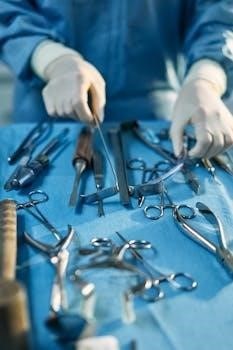Surgical instrument flashcards are educational tools designed to aid in the identification and understanding of various medical-surgical instruments. These flashcards often include images, names, and descriptions, providing a convenient way to learn. They are used by students and practitioners to enhance their knowledge and skills in the operating room. Interactive versions are also available.
Purpose of Surgical Instrument Flashcards
The primary purpose of surgical instrument flashcards is to facilitate the learning process for individuals involved in surgical procedures. These flashcards serve as a visual and informational aid, allowing users to familiarize themselves with the names, functions, and characteristics of various surgical tools. By using flashcards, learners can develop a strong foundation in instrument identification, which is crucial for efficient and safe surgical practices. They offer a structured method for memorizing essential details, ultimately contributing to improved surgical competence. The flashcards are designed to aid in quick recall, helping both students and experienced professionals improve their knowledge and stay up-to-date on the latest instruments and techniques. Furthermore, they promote a deeper understanding of how each instrument contributes to the success of medical procedures. These flashcards are valuable for exam preparation, clinical rotations, and ongoing professional development. They are an essential resource for anyone looking to master the intricacies of surgical instrumentation.
Target Audience⁚ Students and Practitioners
The target audience for surgical instrument flashcards encompasses a wide range of individuals involved in healthcare, primarily students and practitioners. Medical students, particularly those in surgical rotations, benefit greatly from using these flashcards as they learn to identify and understand surgical tools. Nursing students, especially those training for operating room roles, also find them to be a crucial study aid. Surgical technician students rely on flashcards to master instrument names and functions, which are essential for their daily tasks in the operating room. Furthermore, practicing surgeons, physician assistants, and registered nurses can use flashcards for continuing education, helping them to stay updated on new instruments and surgical techniques. These flashcards also serve as a valuable resource for those who are preparing for certification exams in surgical fields. Essentially, anyone working directly or indirectly with surgical instruments can benefit from using these flashcards to improve their knowledge and skills. The accessibility and portability of flashcards make them ideal for a broad audience.

Types of Surgical Instrument Flashcards
Surgical instrument flashcards come in various formats, including those focusing on general instruments, specialized tools for laparoscopic or robotic surgery, image-based cards, and those with detailed descriptions. These variations cater to different learning needs and preferences.
General Surgical Instruments
Flashcards focusing on general surgical instruments are foundational for anyone entering the medical field. These cards typically cover a wide array of tools used in various surgical procedures. They include instruments like hemostats, which are used to clamp blood vessels, and various types of forceps for grasping and manipulating tissues. Scissors, such as operating and dissecting scissors, are also common. Needle holders, essential for suturing, are another key component of these flashcards. The purpose of these flashcards is to provide a comprehensive overview of basic instruments that are utilized in almost all surgical settings. Learning these instruments is crucial for understanding surgical procedures and assisting effectively in the operating room. Furthermore, these flashcards often feature clear images and detailed descriptions to aid in accurate identification and understanding of each tool’s specific use. This is beneficial for students and practitioners alike, allowing for quick and efficient study, facilitating a better grasp of the foundational tools used in surgery.
Specialized Instrument Flashcards (Laparoscopic, OB-GYN, Robotic, Ortho)
Specialized instrument flashcards cater to specific surgical disciplines, offering detailed information on tools unique to each area. Laparoscopic flashcards feature instruments designed for minimally invasive surgeries, such as trocars, graspers, and specialized scissors. OB-GYN flashcards highlight instruments used in obstetrics and gynecology, including speculums, forceps for delivery, and retractors. Robotic surgery flashcards showcase the unique tools used in robotic-assisted procedures, like robotic arms and specialized end effectors. Orthopedic flashcards display instruments specific to bone and joint surgery, including drills, saws, and plates. These specialized flashcards are crucial for students and practitioners looking to focus on or refine their knowledge in these particular fields. They provide the necessary information for the identification and understanding of these complex and specialized instruments. The cards often include images and descriptions specific to each instrument’s application within their respective discipline, aiding in a deeper, more focused learning experience. This ensures that users are well-prepared for the specific challenges of each surgical specialty.
Image-Based Flashcards
Image-based flashcards are a crucial visual aid in learning about surgical instruments, providing detailed pictures of each tool. These flashcards are designed to help students and practitioners quickly recognize and differentiate between various instruments by sight. They often feature high-quality, full-color images that clearly display the instrument’s shape, size, and unique characteristics. The visual component is particularly effective for memorization, as it allows the learner to associate the name and function of the instrument with its physical appearance. This type of flashcard is especially useful for those who are visually oriented learners, making the process of learning the vast array of surgical instruments more accessible and engaging. The images may include different angles or close-ups to highlight specific details, such as the instrument’s tips, jaws, or handles. This level of detail enhances comprehension and allows for a more thorough understanding of the surgical tools. These image-based flashcards are a fundamental resource for anyone seeking to master surgical instrument recognition.
Flashcards with Detailed Descriptions
Flashcards with detailed descriptions go beyond simple identification, offering comprehensive information about each surgical instrument. These flashcards typically include not only the instrument’s name but also its specific uses, common applications, and key features. The detailed text may cover the instrument’s category, such as whether it is a clamp, forceps, or scissor, and explain how it is used in different surgical procedures. This deeper level of information aids in a more thorough understanding of the instrument’s role in the operating room. The descriptions often include details about the materials used to construct the instrument and any relevant maintenance or sterilization considerations. This comprehensive approach is beneficial for both students and seasoned practitioners. The descriptions can also clarify the instrument’s variations, such as different sizes or styles, which are essential for precise surgical practice. Such thorough details enhance the learning process, promoting a more complete and lasting understanding of surgical instrumentation and its practical applications.

Utilizing Surgical Instrument Flashcards
Surgical instrument flashcards can be utilized through various study methods, including self-quizzing and interactive games. Flashcard apps and digital resources offer additional ways to enhance learning and memorization of instruments.
Study Methods with Flashcards
Effective study methods with surgical instrument flashcards include active recall, where you attempt to identify the instrument and its purpose before checking the answer. Spaced repetition is another beneficial technique, reviewing flashcards at increasing intervals to improve long-term retention. Categorizing flashcards by instrument type or surgical specialty can help organize learning. Using flashcards in a group study setting can also be advantageous, allowing for peer quizzing and collaborative learning. Furthermore, integrating flashcards into practical scenarios, such as mock surgical setups, can enhance real-world application. Image-based flashcards are particularly useful, allowing you to visualize the instruments. Regular review and consistent use of the flashcards are essential for mastering instrument identification and usage. Combining flashcards with other study resources, like textbooks and videos, can create a comprehensive learning experience. Finally, make sure to review the information consistently and actively; This will help to solidify the material in your memory.
Interactive Flashcard Quizzes
Interactive flashcard quizzes offer a dynamic approach to learning surgical instruments, moving beyond traditional paper-based methods. These quizzes often present an image of an instrument, prompting users to identify it by name and function within a given time limit. Some quizzes include multiple-choice options, while others require typed answers, promoting active recall. Immediate feedback is often provided, helping users quickly correct errors and reinforce learning. Many platforms offer adaptive quizzing, adjusting difficulty based on individual performance. Interactive quizzes can also track progress, highlighting areas of strength and weakness. Furthermore, timed quizzes simulate the pressure of a real surgical environment. Gamification elements, such as points and leaderboards, can make the learning process more engaging and motivating. These interactive quizzes are accessible on various devices, allowing for study at any time and place. Such methods enhance memorization by combining visual and active learning techniques, making them a valuable tool for students and practitioners alike. Also, interactive quizzes can be customized to focus on specific areas of weakness.
Flashcard Apps and Digital Resources
Flashcard apps and digital resources have transformed surgical instrument learning, offering a convenient and interactive alternative to traditional methods. These platforms provide a vast collection of flashcards, often with high-quality images and detailed descriptions. Many apps offer customizable study sets, allowing users to focus on specific instruments or categories. Digital resources often include features such as spaced repetition algorithms, which help optimize memorization. Interactive quizzes and progress tracking capabilities are commonly integrated, providing valuable feedback and motivation. Some apps also offer collaborative features, allowing users to share flashcards and study together. The portability of mobile devices means that learning can occur anytime, anywhere. These digital tools often provide access to updated content, ensuring that users are always learning the most current information. Furthermore, digital resources can be more environmentally friendly than paper-based materials. These apps and resources cater to various learning styles, offering visual, auditory, and kinesthetic learning opportunities. Overall, digital flashcard apps and resources are a valuable asset for students and practitioners seeking to enhance their surgical instrument knowledge.

Benefits of Using Surgical Instrument Flashcards
Using surgical instrument flashcards greatly improves identification skills, enhances memorization of names and uses, and aids in preparation for exams. These tools are invaluable for both students and practicing professionals.
Improved Instrument Identification Skills
Surgical instrument flashcards are a powerful tool for honing instrument identification skills, a critical competency for anyone working in a surgical environment. By utilizing flashcards, learners can quickly familiarize themselves with the visual characteristics of various tools, including their shape, size, and specific features. These flashcards often present clear images, allowing for a detailed examination of each instrument. This visual learning approach aids in recognizing instruments rapidly and accurately. Regular practice with flashcards leads to a more confident and efficient ability to identify surgical tools. This improved skill set is crucial for safe and effective surgical procedures. Furthermore, the use of flashcards allows for repeated exposure, reinforcing the recognition process and solidifying identification skills. This familiarity with instruments is not only beneficial for students but also for seasoned professionals seeking to refresh their knowledge. Ultimately, the use of flashcards translates to reduced errors, faster instrument retrieval, and an overall enhancement of surgical team performance.
Enhanced Memorization of Instrument Names and Uses

Surgical instrument flashcards are instrumental in enhancing the memorization of both instrument names and their specific uses. The flashcard format allows for repetitive review, a proven method for solidifying memory. Each card typically pairs the image of an instrument with its corresponding name and a brief description of its function, facilitating a strong association between the visual, name, and purpose of the tool. This multisensory approach significantly improves retention compared to simple text-based learning. Regular use of flashcards enables learners to quickly recall the correct instrument name upon seeing its image, and vice-versa. This enhanced memorization translates to more efficient preparation for surgical procedures. Moreover, flashcards allow for targeted study, focusing on specific instruments or categories as needed. By repeatedly engaging with the flashcards, learners build a robust memory foundation that supports their practical application of surgical instruments. This improved recall ability contributes significantly to smoother and safer surgical operations.
Preparation for Exams and Practical Application
Surgical instrument flashcards are invaluable for preparing for both theoretical exams and practical applications in the medical field. These flashcards provide a focused and efficient way to review the vast array of instruments that students and practitioners need to know. The structured format of flashcards, featuring images, names, and functions, is ideal for quick review sessions, making them perfect for exam preparation. Furthermore, the repetitive nature of flashcard study helps in retaining information effectively, ensuring better performance during assessments. The practical aspect of flashcards is also significant, as they aid in building a strong mental library of surgical tools. This mental library enhances the ability to quickly identify and select the appropriate instrument during actual surgical procedures. By enabling quick instrument recognition, flashcards facilitate a smoother and more efficient workflow in the operating room, reducing errors and improving overall patient care. The knowledge gained from flashcards bridges the gap between theoretical understanding and practical skills, leading to well-prepared and confident medical professionals.
